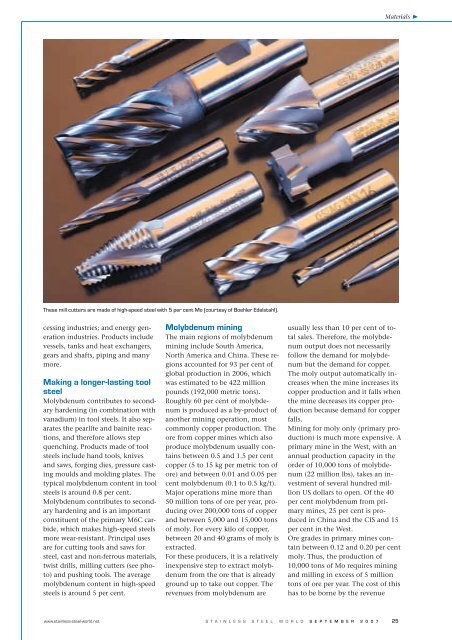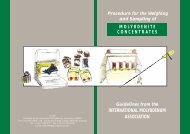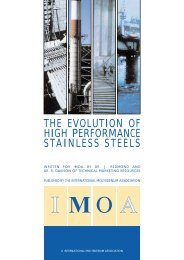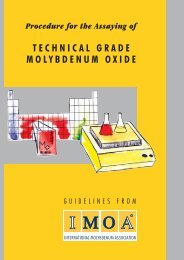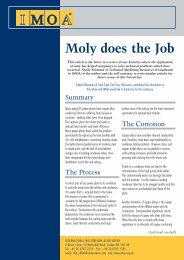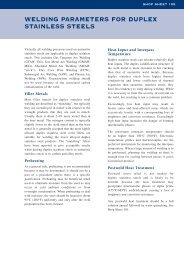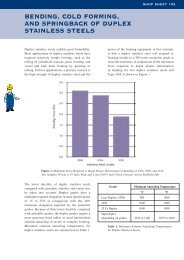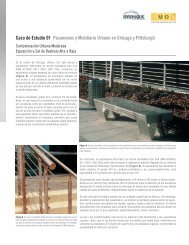Molybdenum - an extraordinary metal in high demand - IMOA
Molybdenum - an extraordinary metal in high demand - IMOA
Molybdenum - an extraordinary metal in high demand - IMOA
Create successful ePaper yourself
Turn your PDF publications into a flip-book with our unique Google optimized e-Paper software.
Materials<br />
These mill cutters are made of <strong>high</strong>-speed steel with 5 per cent Mo (courtesy of Boehler Edelstahl).<br />
cess<strong>in</strong>g <strong>in</strong>dustries; <strong>an</strong>d energy generation<br />
<strong>in</strong>dustries. Products <strong>in</strong>clude<br />
vessels, t<strong>an</strong>ks <strong>an</strong>d heat exch<strong>an</strong>gers,<br />
gears <strong>an</strong>d shafts, pip<strong>in</strong>g <strong>an</strong>d m<strong>an</strong>y<br />
more.<br />
Mak<strong>in</strong>g a longer-last<strong>in</strong>g tool<br />
steel<br />
<strong>Molybdenum</strong> contributes to secondary<br />
harden<strong>in</strong>g (<strong>in</strong> comb<strong>in</strong>ation with<br />
v<strong>an</strong>adium) <strong>in</strong> tool steels. It also separates<br />
the pearlite <strong>an</strong>d ba<strong>in</strong>ite reactions,<br />
<strong>an</strong>d therefore allows step<br />
quench<strong>in</strong>g. Products made of tool<br />
steels <strong>in</strong>clude h<strong>an</strong>d tools, knives<br />
<strong>an</strong>d saws, forg<strong>in</strong>g dies, pressure cast<strong>in</strong>g<br />
moulds <strong>an</strong>d mold<strong>in</strong>g plates. The<br />
typical molybdenum content <strong>in</strong> tool<br />
steels is around 0.8 per cent.<br />
<strong>Molybdenum</strong> contributes to secondary<br />
harden<strong>in</strong>g <strong>an</strong>d is <strong>an</strong> import<strong>an</strong>t<br />
constituent of the primary M6C carbide,<br />
which makes <strong>high</strong>-speed steels<br />
more wear-resist<strong>an</strong>t. Pr<strong>in</strong>cipal uses<br />
are for cutt<strong>in</strong>g tools <strong>an</strong>d saws for<br />
steel, cast <strong>an</strong>d non-ferrous materials,<br />
twist drills, mill<strong>in</strong>g cutters (see photo)<br />
<strong>an</strong>d push<strong>in</strong>g tools. The average<br />
molybdenum content <strong>in</strong> <strong>high</strong>-speed<br />
steels is around 5 per cent.<br />
<strong>Molybdenum</strong> m<strong>in</strong><strong>in</strong>g<br />
The ma<strong>in</strong> regions of molybdenum<br />
m<strong>in</strong><strong>in</strong>g <strong>in</strong>clude South America,<br />
North America <strong>an</strong>d Ch<strong>in</strong>a. These regions<br />
accounted for 93 per cent of<br />
global production <strong>in</strong> 2006, which<br />
was estimated to be 422 million<br />
pounds (192,000 metric tons).<br />
Roughly 60 per cent of molybdenum<br />
is produced as a by-product of<br />
<strong>an</strong>other m<strong>in</strong><strong>in</strong>g operation, most<br />
commonly copper production. The<br />
ore from copper m<strong>in</strong>es which also<br />
produce molybdenum usually conta<strong>in</strong>s<br />
between 0.5 <strong>an</strong>d 1.5 per cent<br />
copper (5 to 15 kg per metric ton of<br />
ore) <strong>an</strong>d between 0.01 <strong>an</strong>d 0.05 per<br />
cent molybdenum (0.1 to 0.5 kg/t).<br />
Major operations m<strong>in</strong>e more th<strong>an</strong><br />
50 million tons of ore per year, produc<strong>in</strong>g<br />
over 200,000 tons of copper<br />
<strong>an</strong>d between 5,000 <strong>an</strong>d 15,000 tons<br />
of moly. For every kilo of copper,<br />
between 20 <strong>an</strong>d 40 grams of moly is<br />
extracted.<br />
For these producers, it is a relatively<br />
<strong>in</strong>expensive step to extract molybdenum<br />
from the ore that is already<br />
ground up to take out copper. The<br />
revenues from molybdenum are<br />
usually less th<strong>an</strong> 10 per cent of total<br />
sales. Therefore, the molybdenum<br />
output does not necessarily<br />
follow the dem<strong>an</strong>d for molybdenum<br />
but the dem<strong>an</strong>d for copper.<br />
The moly output automatically <strong>in</strong>creases<br />
when the m<strong>in</strong>e <strong>in</strong>creases its<br />
copper production <strong>an</strong>d it falls when<br />
the m<strong>in</strong>e decreases its copper production<br />
because dem<strong>an</strong>d for copper<br />
falls.<br />
M<strong>in</strong><strong>in</strong>g for moly only (primary production)<br />
is much more expensive. A<br />
primary m<strong>in</strong>e <strong>in</strong> the West, with <strong>an</strong><br />
<strong>an</strong>nual production capacity <strong>in</strong> the<br />
order of 10,000 tons of molybdenum<br />
(22 million lbs), takes <strong>an</strong> <strong>in</strong>vestment<br />
of several hundred million<br />
US dollars to open. Of the 40<br />
per cent molybdenum from primary<br />
m<strong>in</strong>es, 25 per cent is produced<br />
<strong>in</strong> Ch<strong>in</strong>a <strong>an</strong>d the CIS <strong>an</strong>d 15<br />
per cent <strong>in</strong> the West.<br />
Ore grades <strong>in</strong> primary m<strong>in</strong>es conta<strong>in</strong><br />
between 0.12 <strong>an</strong>d 0.20 per cent<br />
moly. Thus, the production of<br />
10,000 tons of Mo requires m<strong>in</strong><strong>in</strong>g<br />
<strong>an</strong>d mill<strong>in</strong>g <strong>in</strong> excess of 5 million<br />
tons of ore per year. The cost of this<br />
has to be borne by the revenue<br />
www.sta<strong>in</strong>less-steel-world.net S T A I N L E S S S T E E L W O R L D S E P T E M B E R 2 0 0 7 25


